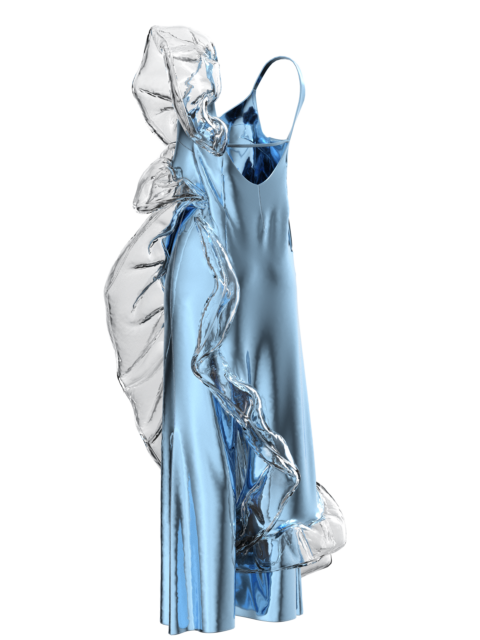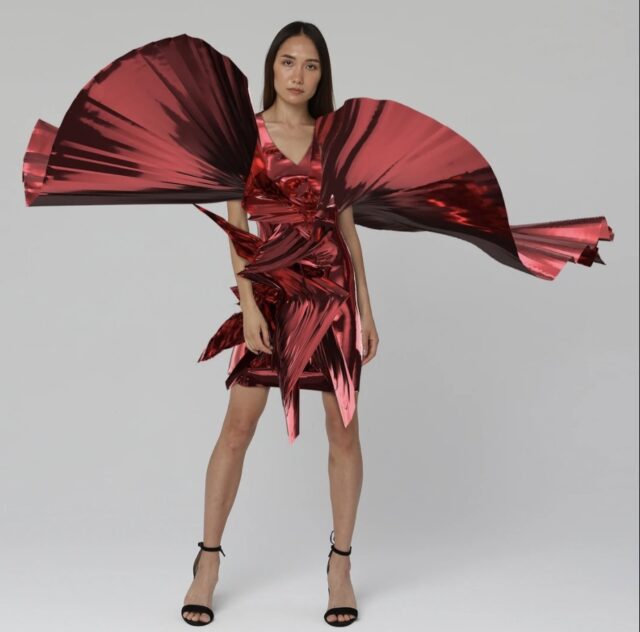If you want more proof that the lines between the digital and physical worlds are blurring, look no further than digital fashion. Cartoon digital avatars have been in style for a while, thanks to social media, with fashion giants like Ralph Lauren even selling clothing for them. Now startups like Los Angeles-based DRESSX are betting that consumers would want to flip the script: Dress their actual physical selves in digital-only clothes for the digital world, creating a “meta” wardrobe.
Founders Daria Shapovalova and Natalia Modenova say the tech startup is about encouraging people to indulge in a stitch of fun with fashion on social media. It is also for those who might like to “try on” a designer outfit for less money than they might otherwise spend.
Sew on point
The DRESSX web marketplace looks like a standard e-commerce site offering choices of clothing. The customer buys a digital representation of a designer outfit from more than 100 designers featured and uploads a high-resolution picture of themselves. Instead of shipping a physical outfit, DRESSX employees digitally overlay the outfit over the picture using a custom in-house process. They then email the finished result for the customer to share on social media or other forums. Designers work on digital-only fashions or create for both the physical and digital worlds.
Technology has progressed enough to make the final digital fashion image look very realistic. However, the images that customers send need to meet certain criteria for digital dressing to work effectively. For example, as of now, customers cannot have hair covering the body as this interferes with the drape of the outfit, and lighting must be adequate, as well. Full-length portraits are preferred, although they can be cropped. As technology gets better over time, expect these limitations to be less stringent, Modenova says.
Customers can choose between still and moving images, where the outfit looks like it is in motion around the body, much like a GIF. Digital fashions at DRESSX range in price from a few dollars for accessories to a couple of hundred dollars for more lavish creations.
Crafting a move toward sustainability
Lavish creations in real life would not only cost a lot more than customers pay for the digital equivalent—they would also be more resource-intensive.
Shapovalova and Modenova argue that digital fashion moves the industry toward sustainability. After all, one less outfit purchased in real life means a lower carbon footprint overall. DressX’s internal research has shown that wearing a digital fashion item has a 97% lower carbon footprint than the physical equivalent. “Sometimes people buy an outfit and wear it just a couple of times to take a picture. Then they return it,” Modenova says. The carbon footprint even in that return is not insignificant, she points out.
“Sometimes people buy an outfit and wear it just a couple of times to take a picture. Then they return it. The carbon footprint even in that return is not insignificant.
“—Natalia Modenova, founder of DRESSX

While the carbon footprint of digital fashion might be low, it still occupies too
specific a niche to dramatically decrease the industry’s overall carbon emissions, says Neil Saunders, the managing director of the retail division of research and consulting firm, GlobalData. “The people buying digital fashion will still need to wear clothes in real life,” Saunders points out. Shapovalova agrees. Digital fashion will not eliminate all physical fashion, but every drop in the sustainability bucket helps. For example, social media influencers who strike deals to promote brands might agree to wear a digital representation of the real thing instead of having an outfit shipped to them and then returned.
“We are providing a different use case for how to consume fashion; both models can coexist,” Shapovalova says. That different use case extends to a digital realm where fashion can do more than what it can in the real world. Sneakers with flames of fire lapping at the edges and a dress made with water drops are just a few of the possibilities with digital fashion.
The social media equation
Enabling customers to “wear” fun designer clothes in this way democratises access, Shapovalova says. About 55% of DRESSX’s customers since their launch in 2020 are female-identifying, and all are tech-savvy, Shapovalova says.
While digital fashion allows for fun on social media, some worry it’s a licence to mine vanity that is already a significant downside of these platforms. A 2020 study of 4,000 young Americans found that they are spending a lot of time online—those aged 16-29 spend an average of 514 minutes online every day—with nearly half feeling judged by others and nearly as much feeling isolated and lonely.
“Everything on social media is about appearances and filtering and an altered reality,” says Lena Derhally, a licensed psychotherapist and author of an upcoming book, Facebook Narcissist: How to Identify and Protect You and Your Loved Ones From Social Media Narcissism.
“The addictive nature of social media and getting validation for how we look is a very slippery slope, especially for young people,” Derhally says. Saunders agrees. Even though “you can’t fault a company for supplying what people demand,” he says, “it does create a lot of pressure to constantly be seen in new things.”
“The addictive nature of social media and getting validation for how we look is a very slippery slope, especially for young people.
“—Lena Derhally, psychotherapist
Shapovalova, however, sees social media as a tool to communicate with friends. “You can use a tool for bad or good,” she says. “We are providing a creative use case for how you can have fun with fashion without paying too much money.”
What’s in it for designers
Digital fashion as a social media tool also creates an additional—if small—revenue stream for designers. Many artists design for the digital-only space, and they find a mutually beneficial partnership with platforms like DRESSX.

In some cases, designers make certain versions of their creations available for
digital fashion. Ralph Lauren, for example, sells fashions for digital avatars in the emerging metaverse. In such cases, the exercise is mostly marketing-driven, Saunders says. But having designers create such fashions for real people to “wear” is an entirely different matter. Saunders suggests that designers might shy away from sharing all creations for wearing through AR.
“One of the balancing acts with fashion is that while you want your brand to be publicised, you don’t want availability to be too ubiquitous,” Saunders says. “One of the ways many design houses manage this dance is through high prices. Now, if it’s worn by everyone, designers lose that exclusivity.”
Here, too, digital fashion has a solution: Non-fungible tokens (NFTs) traded using blockchain. When a digital outfit is created (tokenised) as an NFT, it can be saved or resold just like another piece of clothing. Because digital assets are easier to copy and trade, these NFTs will have to live on a blockchain ledger, which means every transaction will be permanently recorded and can be verified. DRESSX is ready to launch some of its digital fashion outfits as NFTs. “Now you have an opportunity to not only collect and wear them, but you can also resell them like in the real world,” Shapovalova says. Brands worried about exclusivity can release a few limited-edition digital NFT pieces that run on a blockchain platform. Customers can then buy and bid on these pieces, which creates marketing buzz.
NFTs and blockchain are indeed where digital fashion is headed next. As we spoke, Shapovalova and Modenova were in New York City to attend NFT.NYC, an annual NFT event.
Digital fashion is the way of the future, they say. “We share a vision of the world where people will build digital closets that will be no less significant than the physical wardrobe,” Modenova says. Shapovalova agrees. “I believe that every brand in the world will have a digital fashion category,” she says. “The meta closet is the future.”
Lead photo of Isabelle Boemeke in Nuclear Power Dress designed by Clara Daguin and created by DRESSX. Courtesy of DRESSX.
This blog first featured on the Dell Technologies Global blog.

